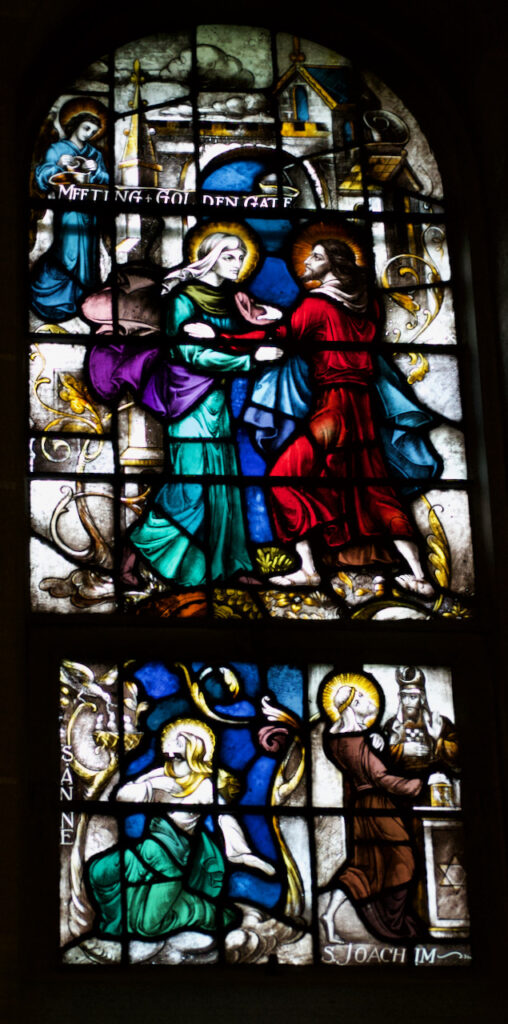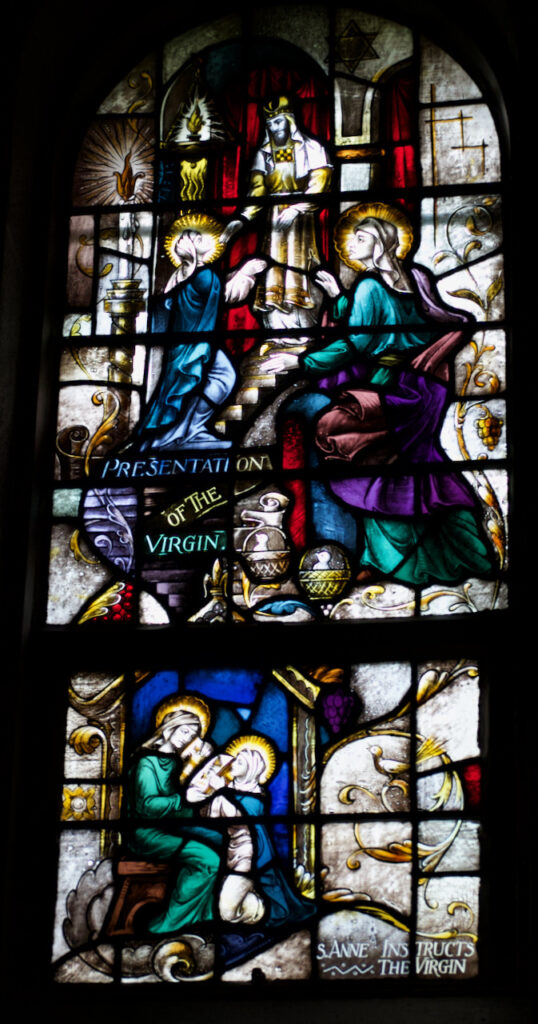
Not much historical information is known about St. Anne and Joachim, the grandparents of Jesus, whose feast day is July 26. The windows at the St. Anne altar depict four scenes from their lives, based on legend or tradition. They are some of the most symbolically complex windows in the church.
The couple was childless, and in their culture, this was considered a punishment by God. Anne begged God for a child in prayer and promised to dedicate the child to the Lord. The scene in the upper left window is of Anne meeting Joachim at a gate of the city. According to legend, Joachim had been expelled from the temple as unworthy because he and Anne had no children. The Angel Gabriel appeared to both of them separately, announcing that they would conceive a child. Ann ran to meet Joachim to tell him the news. Gabriel is in the upper left corner of the window, holding a lily, his attribute. Red and green are colors associated with Anne. The red, worn by Joachim is a symbol of their love. The green worn by Anne is a symbol of rebirth and hope, the hope for the Savior who would be the son of her child, for Anne’s child was Mary, the mother of Jesus.

A vine with golden leaves is a prominent image that winds through the windows, tying the four scenes together. It symbolizes the Immaculate Conception, the article of our faith that Mary was conceived in the womb of Anne without original sin, by God’s grace, that she might be a fitting mother for the Son of God. The vine also suggests the prophecy from Isaiah about Jesus: “…a shoot will sprout from the stump of Jesse”. (Is 11:1) Jesse was the father of King David, and Jesus, through Mary, and Joachim and Anne, was a descendent of David. In the first scene the vine appears and is beginning to grow, its branches embracing both Anne and Joachim.
In the lower left scene, Joachim is in the temple, offering to God two doves in thanksgiving for this unborn child. This was the traditional offering of the poor. Anne is in prayer and the vine now has a nest with baby birds. The mother is feeding her young, a symbol of Anne’s desire for a child.
In the window on the right, Mary has been born. The upper right scene depicts the Presentation of the child Mary in the Temple, as Anne had promised God. Red, symbolizing love for God is prominent. Anne is dressed in green with a purple shawl. Purple is the color of sorrow and penitence, and the purple garment seems to be falling from her, a sign that her suffering has come to an end. The vine now bears fruit, symbolizing Anne as the fruitful vine of Jesse, from which will come the Savior. The birds in baskets are a symbol of Joachim, and perhaps a symbol of making an offering to God. The candle suggests our Easter Candle, symbolizing that the child to be born of Mary will be the Light of the World. Three crosses are hinted at in the upper right corner of the scene, perhaps foreshadowing Jesus’ Passion.
The final scene is of Anne teaching Mary, the most common way of depicting her. Blue, which symbolizes the divine presence of God, and is the color of the Virgin Mary, surrounds them. The bird is now singing with joy. The purple grapes symbolize the fruitfulness of the prophecy from Isaiah that will be fulfilled with the birth of Jesus, Mary’s child. Joachim and Anne surely hoped for the fulfillment of Isaiah’s prophecy. They were close to it’s fulfillment. May we also hope in the love and mercy of God. Although we do not know facts about the life of St. Anne, she must have been influential in the development of Mary’s faith, a faith that allowed her to say “Yes,” to God’s plan for her. May we ask St. Anne to help us to say “Yes” to God, also. And may mothers and grandmothers seek her intercession as they care for the physical and spiritual lives of their children and grandchildren.